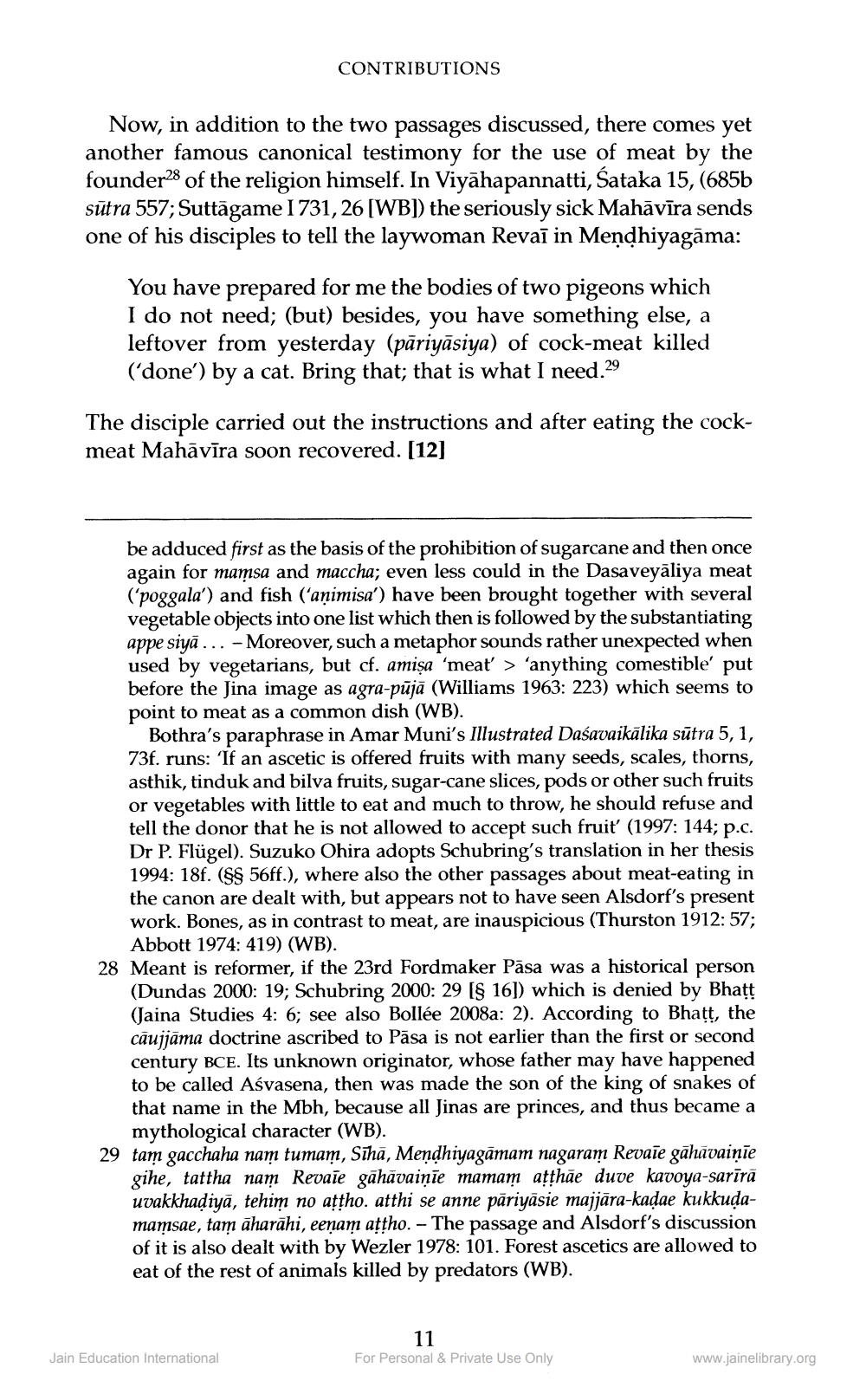________________
CONTRIBUTIONS
Now, in addition to the two passages discussed, there comes yet another famous canonical testimony for the use of meat by the founder28 of the religion himself. In Viyāhapannatti, Sataka 15, (685b sūtra 557; Suttāgame 1731, 26 [WB]) the seriously sick Mahāvīra sends one of his disciples to tell the laywoman Revaī in Mendhiyagāma:
You have prepared for me the bodies of two pigeons which I do not need; (but) besides, you have something else, a leftover from yesterday (pāriyāsiya) of cock-meat killed ('done') by a cat. Bring that; that is what I need. 29
The disciple carried out the instructions and after eating the cockmeat Mahāvīra soon recovered. [12]
be adduced first as the basis of the prohibition of sugarcane and then once again for mamsa and maccha; even less could in the Dasaveyāliya meat ('poggala') and fish ('aņimisa') have been brought together with several vegetable objects into one list which then is followed by the substantiating appe siyā ... - Moreover, such a metaphor sounds rather unexpected when used by vegetarians, but cf. amisa 'meat' > 'anything comestible' put before the Jina image as agra-pūjā (Williams 1963: 223) which seems to point to meat as a common dish (WB).
Bothra's paraphrase in Amar Muni's Illustrated Daśavaikälika sūtra 5, 1, 73f. runs: 'If an ascetic is offered fruits with many seeds, scales, thorns, asthik, tinduk and bilva fruits, sugar-cane slices, pods or other such fruits or vegetables with little to eat and much to throw, he should refuse and tell the donor that he is not allowed to accept such fruit' (1997: 144; p.c. Dr P. Flügel). Suzuko Ohira adopts Schubring's translation in her thesis 1994: 18f. (SS 56ff.), where also the other passages about meat-eating in the canon are dealt with, but appears not to have seen Alsdorf's present work. Bones, as in contrast to meat, are inauspicious (Thurston 1912:57;
Abbott 1974: 419) (WB). 28 Meant is reformer, if the 23rd Fordmaker Pāsa was a historical person
(Dundas 2000: 19; Schubring 2000: 29 (8 16]) which is denied by Bhatt (Jaina Studies 4: 6; see also Bollée 2008a: 2). According to Bhatt, the cāujjāma doctrine ascribed to Pāsa is not earlier than the first or second century BCE. Its unknown originator, whose father may have happened to be called Aśvasena, then was made the son of the king of snakes of that name in the Mbh, because all Jinas are princes, and thus became a
mythological character (WB). 29 tam gacchaha nam tumam, Sīhā, Mendhiyagāmam nagaram Revaie gāhāvainie
gihe, tattha nam Revaie gāhāvaiņie mamam atthāe duve kavoya-sarīrā uvakkhadiyā, tehim no attho. atthi se anne pāriyāsie majjara-kadae kukkudamamsae, tam āharāhi, eenam attho. - The passage and Alsdorf's discussion of it is also dealt with by Wezler 1978: 101. Forest ascetics are allowed to eat of the rest of animals killed by predators (WB).
11 For Personal & Private Use Only
Jain Education International
www.jainelibrary.org




